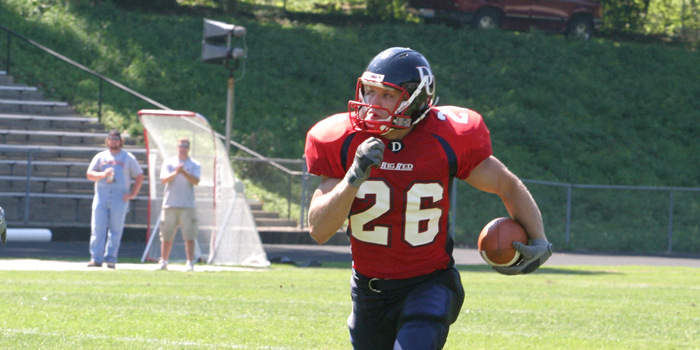
Derek Fry, 2003. photo Denison Sports Information
So there's this thing called Twitter, where you can share your thoughts in 140 characters or less. The benefit is can share small chunks of info and that can be digested and internalized very easily. The negative is that you can sound very vague, opinionated, and downright arrogant.
I've tweeted over 2400 times and there have been plenty that I had to say, 'that didn't sound right' or 'what I really meant was...'
The last thing I ever want to do is come across as arrogant, but in 140 characters, you have to get to the point and some descriptive words like "in most cases" or "for the most part" get lost in the shuffle. The reason I have any voice in this industry is that 1.) Dave has allowed me to have one and 2.) I have made enough mistakes with the humility to learn from them and experience to fix them to pass that info forward.
So a month ago I published a news post based on a study that Carl Valle shared on his Facebook. I included comments from Valle and Dan Baker which drove the point home. If their thoughts and the study didn't align with my personal beliefs, would I have ever shared this? Probably not.
Not quite so fast: effect of training at 90% sprint speed on maximal and repeated-sprint ability in soccer players.
J Sports Sci. 2014 Dec;32(20):1979-1986. Epub 2014 Nov 11.
Abstract
Abstract The aim of the present study was to investigate the effect of training at an intensity eliciting 90% of maximal sprinting speed on maximal and repeated-sprint performance in soccer. It was hypothesised that sprint training at 90% of maximal velocity would improve soccer-related sprinting. Twenty-two junior club-level male and female soccer players (age 17 ± 1 year, body mass 64 ± 8 kg, body height 174 ± 8 cm) completed an intervention study where the training group (TG) replaced one of their weekly soccer training sessions with a repeated-sprint training session performed at 90% of maximal sprint speed, while the control group (CG) completed regular soccer training according to their teams' original training plans. Countermovement jump, 12 × 20-m repeated-sprint, VO2max and the Yo-Yo Intermittent Recovery Level 1 test were performed prior to and after a 9-week intervention period. No significant between-group differences were observed for any of the performance indices and effect magnitudes were trivial or small. Before rejecting the hypothesis, we recommend that future studies should perform intervention programmes with either stronger stimulus or at other times during the season where total training load is reduced.
Here is the original comment from Carl Valle:
90% isn't going to do much, so if you are going to sprint, time and find out what does help. Hint, more than 90%
Dan Baker had followed up with this statement in reaction to a few inquisitions on the thread. Maybe be a little out of context without the other comments but you get the drift.
This study shows that you do either maximal speed training (@100% OR CLOSE TO IT) or do energy system training (aerobic/anaerobic). Repeat speed does not make you faster or improve repeat sprint ability anymore than normal sport training, so why bother. Buchheits long term study showed if you did max sprint work and aerobic conditioning, you get an improvement in repeat sprint tests (as well as get faster and aerobically fitter). I agree with Carl Valle, get data and make informed decisions on training content.
- Dan Baker
Here are some additional references Dan provided on the thread in which the abstract was included.
Changes in repeated-sprint performance in relation to change in locomotor profile in highly-trained young soccer players by MARTIN BUCHHEIT & ALBERTO MENDEZ-VILLANUEVA. JSS 2014.
"To conclude, present results show that changes in repeated-sprint performance are moderately-to- largely related to changes in (young) players’ loco- motor profile, which is determined by their maximal sprinting and aerobic speeds. These results suggest that these two key running speeds, which can be easily assessed via low-cost field test, can be used to monitor training-induced changes in more soccer- specific efforts such as repeated sprints."
Given these results based upon longer term training, why bother doing repeat sprint training. GET FAST & GET FIT!, takes care of most shit in soccer, physical wise....
- Dan Baker
So to add more fuel to my fire, Patrick Ward, who I have a ton of respect, quotes Louie Simmons on his Facebook page.
"A strong child is always better at running, jumping, and throwing than a weak child. This formula should work throughout the sports career for all athletes. The max effort method is superior to all training methods, but seldom used in sports. This is ridiculous because the maximal effort method is superior to all methods for improving intramuscular and inter-muscular coordination. Sports science has proven that the CNS and muscles adapt only to the demands or loads placed upon them." - Do I really need to mention who said this?
Ward was referring to Simmons' quote without much judgment. After some unrelated or misguided comments from some who may have missed the point, Ward added this.
The quote above had nothing to do with training kids though....I think you take it out of context. He was just saying that strong kids usually do things better than weak kids at a young age; however, with athletes we tend to forget that maximal strength is beneficial and opt for other training methods. - Patrick Ward
Oversimplified? Maybe. But, in my opinion, Valle, Baker, Simmons, and Ward are all correct. With the limited resources coaches have the the specific population they work with, strength may be the underlying factor that can improve games speed in field or court sports. The problem was, many coaches feel the answer is much more complicated. In a way they are right. But, every coach's situation is different. Here is the tweet I sent.
Athletes' sprint intensity should be high enough to develop speed or low enough to elicit recovery. Not full speed = not developing speed.
— Mark Watts (@Elitefts_EduDir) June 5, 2015
Now, there is a lot more to it than that. My general takeaway points are these. For field and court sports, speed is essentially...
- The ability to cover as much of the field in the shortest time possible
- Linear speed is defined by a very simple formula: Stride Length x Stride Frequency.
- In other words, the more ground you cover on each step and the more steps you can take in a given time, the better.
- As coach Buddy Morris has stated stride length is a bi-product of speed and not the reverse.
- A positive fact about speed training is stride length is a more trainable quality than stride frequency.
- This half of the equation is enhanced by improved anterior chain flexibility and increased posterior chain and torso strength.
- Basically, the more force you apply to the ground, the more ground you will cover.
- Strength = Speed.
The other part of this tweet that needed more definition is the notion of actually running full speed. I am in no way saying that running at speeds less than 90% will inhibit speed mechanics. My suggestion is only that with the amount of time allotted, full-speed sprinting is a better allocation of resources. Here is something I wrote about the matter in an my last article, Summer Training for Football.
As a general rule, if an athlete is not running at full speed, they are not developing speed. An athlete sprinting at less than full-speed is usually not attributed to effort, but rather fatigue due to condensed rest intervals or inappropriate volume. Determining rest intervals can be as simple as understanding the applicable work to rest ratio. We have adapted a formula from Charlie Francis for non-track athletes. Normally, at least 30 seconds of rest for each second a sprint lasts. For example, if an athlete is sprinting a 40 yard dash in approximately 5 seconds; that rest interval should be about two and a half minutes. Total volume should usually be about 200-300 yards for all combined sprints.
Remember where my background and experience has been. I am not a track coach, a biomechanist, or and exercise physiologist. I was a coach who needed to train a large amount of athletes in a short amount of time. So the tweet I sent had quite a few favorites and retweets along with a few replies from coaches like Jeremy Boone who agreed with the basic sentiment. And then I got this reply....
@Elitefts_EduDir @jdcford not correct — Stuart McMillan (@StuartMcMillan1) June 5, 2015
So my first inclination is to say, "Ok, buddy. You aren't getting away with that. You have to elaborate. Turns out Stuart McMillan is pretty smart and writes a blog. I ironically he is currently writing a 5 part series on strength training. I have no idea who he trains, but as you will see, he has a following.
So, I will give a play-by-play of the twitter responses. I am really glad it happened, because even if I am wrong it would be a great learning experience for me and anyone else following. So here goes:
Speed Training on Twitter
I will screen shot these instead of embedding them for lack of time.
So what I learned from this interaction is that I am labeled as a Charlie Francis guy, which is good with me. There is a great point by Gieseppe in the fact that can athletes really produce 95% and my question is: Can they really tell the difference? I had enough issues for them deciphering between half-speed and 3-quarter speed. Finally I agree with Ross. How much time do we really have to teach mechanics when they are learning other sport skills. As I started to learn Stuart's background, it became more clear.
So, Stuart is talking about training elite Jamaicans and I'm talking about training college, non-track athletes. No wonder we aren't connecting at this point. Some of the replies are hidden and people are asking for non Charlie Francis resources from Stuart.
From there, Ross Bennet made a few statements about the dilemma of speed mechanics and field sports.
Athletes in 'non sprinting' sports learn how to be effective and control their bodies movement
in football for example, athletes need to have feet close to the ground at all times to be able..
Stu (I'm going to call im Stu now) followed up with this:
@Elitefts_EduDir @jdcford I'm talking about every athlete on the face of the planet. ⬆️ mechanics = ⬆️ speed. Why is that controversial?
— Stuart McMillan (@StuartMcMillan1) June 5, 2015
I just think he is missing the point. He is absolutely correct in that mechanics are important. But, track athletes are not the same as field or court sport athletes. 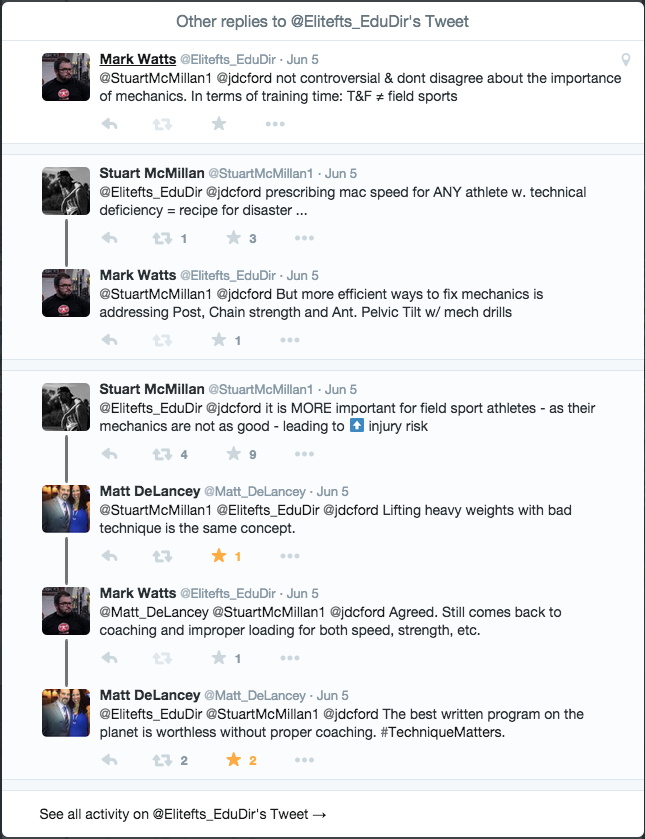 So here is where Stuart and I are going in different directions. My thought process deals with effort. When do athletes learn who to produce the maximal force they are capable of. Realizing that athletes have a difficult time with producing this force, I have never been in a situation where I could ask the athletes not to sprint at full-speed. Sprint full speed with technique deficiency is similar to lifting maximally with poor form, as Matt DeLancey who is an outstanding coach echoes. But, it's not exactly the same and hard to compare. A maximal load in the weight room is a load in which the athlete may have never attempted before. Maximal sprinting is a task that all athletes are required to do for success in their sport. Although the loads are much greater in sprinting when velocity and force are considered, the skill is much more familiar. I may be way off, but that is my experience. When in doubt, increase Posterior chain strength and increase mobility and flexibility in the anterior chain. Here is something I wrote a while back based on DeFranco's and Rooney's thoughts on strength training for speed.
So here is where Stuart and I are going in different directions. My thought process deals with effort. When do athletes learn who to produce the maximal force they are capable of. Realizing that athletes have a difficult time with producing this force, I have never been in a situation where I could ask the athletes not to sprint at full-speed. Sprint full speed with technique deficiency is similar to lifting maximally with poor form, as Matt DeLancey who is an outstanding coach echoes. But, it's not exactly the same and hard to compare. A maximal load in the weight room is a load in which the athlete may have never attempted before. Maximal sprinting is a task that all athletes are required to do for success in their sport. Although the loads are much greater in sprinting when velocity and force are considered, the skill is much more familiar. I may be way off, but that is my experience. When in doubt, increase Posterior chain strength and increase mobility and flexibility in the anterior chain. Here is something I wrote a while back based on DeFranco's and Rooney's thoughts on strength training for speed.
MECHANICS
Not going to go into detail about how we used to teach linear speed mechanics, but address each component. These are mostly single joint exercises.
Posture
1.) Blast Strap™Abdominal Fall Outs
2.) Ankle Mobility/ Anterior Tibialis
Arm Action
*don't do hammer curls for this. You should be teaching to throw the hands back
1.) Rows
2.) Face-Pulls
3.) Tricep Push-downs
Leg Action
Front-Side Mechanics (Triple Flexion)
1.) Hanging Leg Raises
2.) Seated Band Curls
3.) Anterior Tibialis
Backside Mechanics (Triple Extension)
1.) Hip Thrusters
2.) Band TKEs
3.) Calf Raises
LINEAR SPEED ACCELERATION (THE START)
Specifically the first 3 steps of acceleration. Included will be a different modalities for each exercise.
Ballistic
1.) Med Ball Throws for Height
2.) Kneeling Jump (SL or DL)
Olympic
1.) Power Snatch from Blocks
2.) Power Clean from Floor
Dynamic
1.) Box Squat with Bands
2.) Speed pulls with Bands from Deficit
Max Effort
1.) Conventional Deadlift
LINEAR SPEED (TOP-END SPEED)
Ballistic
1.) SL Sprints
2.) Depth Jump
3.) Stair Bounds
Dynamic
1.) Glute Ham Raise
*This is the number one exercise overall for speed development along with squats and deadlifts.
LATERAL SPEED
These exercises would benefit the deceleration, amortization, and acceleration phases.
Ballistic
1.) Skater Jumps
2.) Shuffle with Rotational MB Throw
3.) SL Lateral Box Jumps
Olympic
1.) Snatch Balance
2.) KB Swings
Dynamic
1.) Box Squat with Bands
2.) Sumo pulls with Chains
Max Effort
1.) Squat
*When in doubt, do these.
Regardless, Matt DeLancey is dead-on. It still comes down to the coaching. McMillan responded with a couple of statements that I really disagree with.
it is this type of thinking that sees incidence of hamstring injury continue to rise in team sports. - Stuart McMillan Hamstring injuries high IF Sprints programmed incorrectly or athletes strength levels are insufficient to fix mech - Mark Watts

Basically, my biggest question for every speed guru anywhere and everywhere is 'HOW are you fixing mechanics?' Is it just by cueing, specialized mechanic drills, what? Now, I want everyone to know that just because I don't agree with Stuart McMillan or other coaches who a share his views means that I don't respect his views. It also doesn't mean that I am right. What I have concluded is that we are coming from different backgrounds and the athletes we have trained are vastly different. Context as much as content.
Long-Term Athlete Development
I could go on with screenshots, and embedded tweets. There are over 300 responses and interactions on this thread. I even heard that the LTAD model is a total bullocks. I didn't know what a bullocks was, but I disagree and feel the Long-Term Athlete Development Model is an adequate guideline for coaches in terms of coaching in those windows. See, this is where I fee a lot of coaches got this minor detail wrong. LTAD model in terms of developmental windows doesn't mean you don't continually coaches youth athletes on proper mechanics. It simple means that there are periods in the athletes development in which they are more receptive to those adaptations. Sprinting is a skill and should be done all the time.  Apparently, there are coaches out there who don't believe in the model but have never referred to another model which is more appropriate. Later on, I was included in a response from Rhodri Lloyd about some research they had done on maturation and youth training and those windows of opportunities. From the study, it seems there aren't windows where training i necessarily missed, but that is more suited for certain types of training which builds off of previous phases.
Apparently, there are coaches out there who don't believe in the model but have never referred to another model which is more appropriate. Later on, I was included in a response from Rhodri Lloyd about some research they had done on maturation and youth training and those windows of opportunities. From the study, it seems there aren't windows where training i necessarily missed, but that is more suited for certain types of training which builds off of previous phases.
Developing Speed Throughout Childhood and Adolescence: The Role of Growth, Maturation and Training
Oliver, Jon L.; Lloyd, Rhodri S.; Rumpf, Michael C.Strength & Conditioning Journal. 35(3):42-48, June 2013. ABSTRACT: SPEED IS A FUNDAMENTAL COMPONENT OF MANY SPORTS, AND THE ABILITY TO SPRINT IS OFTEN A DISTINGUISHING CHARACTERISTIC OF SUCCESSFUL PERFORMANCE. THIS ARTICLE REVIEWS EVIDENCE EXAMINING SPEED DEVELOPMENT DURING CHILDHOOD AND ADOLESCENCE, WITH A SPECIFIC FOCUS ON THE IMPACT OF MOVEMENT SKILL AND PHYSIOLOGICAL AND BIOMECHANICAL FACTORS. GUIDELINES ARE PROVIDED TO ASSIST STRENGTH AND CONDITIONING COACHES WITH LONG-TERM PLANNING OF TRAINING TO MAXIMIZE SPEED DEVELOPMENT THROUGHOUT CHILDHOOD AND ADOLESCENCE. The theory of “windows of opportunity” suggests a period of time during childhood when responsiveness to training will be maximized, and, potentially, that a failure to fully use such a period will limit future achievement (2,3). There is a lack of empirical evidence to support this theory (1,13), and no studies have specifically been designed to test such a hypothesis. However, many discrete studies have all shown a variety of training methods to elicit speed gains in children and adolescents. These studies show that FMSs (42), coordination (43), stabilization, and proprioceptive training (21) can elicit speed gains in prepubescent children. Plyometric training has been reported to succeed at improving speed for athletes who are prepubescent (22), circumpubescent (30), and fully mature (36). Strength training has also been demonstrated to transfer to speed gains in prepubescent (17), circumpubescent (8), and postpubescent (9) athletes.
The coach should use these guidelines to help produce a long-term plan for developing speed, and to inform the types of exercises that are most appropriately aligned to different stages of growth andmaturation. The focus of this approach is to maximize long-term gains in speed. It should be emphasized that similar to adults, programming for youths should always take an individualized approach (25) and the coach will need to consider the needs of each athlete to maximize the likelihood of continued progress through a long-term program.
Speed Training
In terms of speed training, most of my philosophy was represented from a picture from Charlie Francis that Kevin Cronin of Colorado College shared who shares the same outlook.
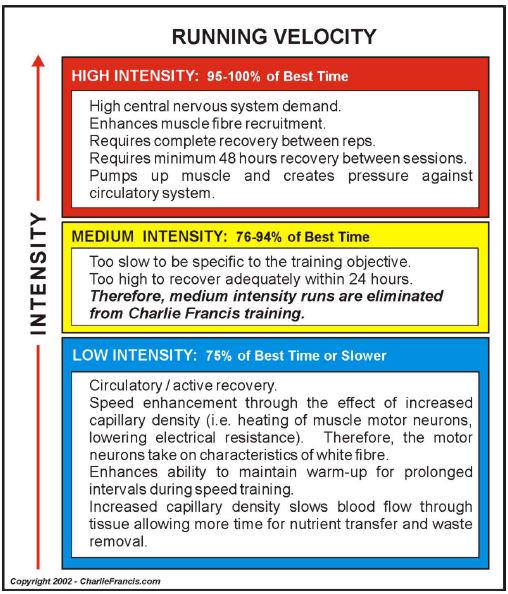 Right or wrong, it what I believe. Not because Charlie said it or I've heard hundreds of coaches echo it; but because it matched up to the anecdotal data I have collected over 15 years of coaching. The training drives the data, the data should drive the training. Some highlights of the twitter conversation included three individuals I look up to in the field. Nick Winkleman, Derrick Hansen, and Rhodri Lloyd. It was refreshing to see I was at least on the write track. Winkleman had made some great points and alluded to the fact there are strong, healthy athletes with inefficient mechanics. Yes, there are athletes that are fast in spite of their mechanics. I've seen coach Tom Shaw present on speed training and the man who trained Dion Sanders and Chris Johnson had admitted to working diligently with Johnson's arm mechanics. When it was time for Johnson to run at the combine, he reverted back to the same cross-body arm action and ran one of the fastest times in combine history. I still believe with the athlete that most of us work with the the time we have allotted, strength training will give more band for your buck. Especially, when most of my athletes never ran more than 40 yards in a straight line and often had a stick in their hand. Here is a tweet from Hansen that made my day.
Right or wrong, it what I believe. Not because Charlie said it or I've heard hundreds of coaches echo it; but because it matched up to the anecdotal data I have collected over 15 years of coaching. The training drives the data, the data should drive the training. Some highlights of the twitter conversation included three individuals I look up to in the field. Nick Winkleman, Derrick Hansen, and Rhodri Lloyd. It was refreshing to see I was at least on the write track. Winkleman had made some great points and alluded to the fact there are strong, healthy athletes with inefficient mechanics. Yes, there are athletes that are fast in spite of their mechanics. I've seen coach Tom Shaw present on speed training and the man who trained Dion Sanders and Chris Johnson had admitted to working diligently with Johnson's arm mechanics. When it was time for Johnson to run at the combine, he reverted back to the same cross-body arm action and ran one of the fastest times in combine history. I still believe with the athlete that most of us work with the the time we have allotted, strength training will give more band for your buck. Especially, when most of my athletes never ran more than 40 yards in a straight line and often had a stick in their hand. Here is a tweet from Hansen that made my day.
@Elitefts_EduDir This is what I have been presenting on for years. Proof is in the pudding. pic.twitter.com/lHkepAO8rR — Derek M. Hansen (@DerekMHansen) June 5, 2015
Hansen wrote a chapter in High-Performance Training for Sports entitled Successfully Translating Strength Into Speed.
To follow up on this thinking, here is a link to a research review from Ryan Colquhoun comparing max strength and running speed.
Read the entire article here:
http://thestrengthcave.com/research-review-comparing-max-squat-and-sprint-times/
Basically, Colquhoun summarized the finding as:
Conclusions
There are 2 main points to this paper:
-
Relative Strength = Acceleration
-
Absolute Strength = Sprinting
I may have thought the opposite, initially. The study is more comparing strength levels as opposed to speed development correlating to strength gains.
Finally, I got to see Boo Schexnayder present at the NSCA National Conference in Orlando last week. I have heard great things about Coach Schexnayder from Carl Valle amoung others. Bryan Mann raved about his first presentation, so I know I had to attend to the second. Hats off to Scott Caulfield again for an unbelievable line-up.
A few things that go my attention from Boo's presentation.
"A hard or easy workout shouldn't be based on coach/ athlete perception. It should be based at the tissue level" - Boo Schexnayder #NatCon15
— Mark Watts (@Elitefts_EduDir) July 10, 2015
What Schexnayder means is, we as coaches after pre-determined how difficult a workout is based on perception of the coach, or even worse, the perception of the perception of the athlete. We as coaches need to determine the intensity of a training session less on how people feel it was (or will be) and base it off the physiological stress that is happening as a result of the training. Another quote I had to tweet from Boo was:
In order to effectively train power/ speed, you have to be able to express power/ speed. Recovery is imperative. - Boo Schexnayder #NatCon15 — Mark Watts (@Elitefts_EduDir) July 10, 2015
This brings me to the last point and circles back to my original tweet. Let's try replacing the word maximal speed with "full-speed" as in full-effort. This is what I failed to say in 140 characters. If you are not fully recovered before you sprint, because of too much volume or too little rest time, you are conditioning, not developing speed. And before you counter with "you have to be fast when you're tired" cliche'; really think about how you can go about training for that.
This is the chart we used, but as Joe Kenn says, "I reserve the right to be wrong."
Determining rest intervals can be as simple as understanding the applicable work to rest ratio. We have adapted a formula from Charlie Francis for non-track athletes. Normally, at least 30 seconds of rest for each second a sprint lasts. For example, if an athlete is sprinting a 40 yard dash in approximately 5 seconds; that rest interval should be about two and a half minutes. Total volume should usually be about 200-300 yards for all combined sprints. Here is an example for a typical session:
Specific Volume can be adjusted by position or in an auto-regulatory fashion. One idea that I learned from Martin Rooney was to base the volume of sprints on performance. This concept would provide a "cut-off" point on sprints once the athlete's time becomes slower.
Conclusion
At West Point, I was in charge of Sprint Football. A team team that were my last three predecessors' nightmare, became one of my most loyal and hard working teams. We had a 6,000 square foot weight room with no platforms, bumpers, ploy-boxes, or access to a track. For 6-8 weeks we squatted, pulled, pressed, rowed, and performed glute-ham raises. When the same coaches tested the players that spring as the spring before, we averaged about a 2-3 tenth improvement. We got faster without running. Would we have improved speed more if they were able to sprint in conjunction with strength training? I believe so. But, its hard to convince me that the ability to produce force doesn't have carryover.
My last year at Denison, we had a direct correlation between squat maxes in terms of bodyweight and 40 yard dash times. The 40s were tested electronically and we would simple divide the estimated max (2-4 reps converted by the Lander formula) by the bodyweight. Now, maybe our skilled guys weren't as fast as they should be and maybe we should have been faster, but it was right there in front of us.
Now I will be the first to admit, that with other sports like Lacrosse, that correlation wasn't there. What we did find was that there was a correlation (statistically significant or not) between vertical jump and 40 yard dash time. What we also figured out was any of the fastest players with good 40 or vert scores and had an average or below 5-10-5 pro agility, also had a discrepancy in the squat. I firmly believe that strength has a much great effect on lateral speed than linear, but that is another article.
When it is all said and done, with the time I have allotted to train speed with field or court athletes (sometime less than an hour per week) and the amount of coaches and space I have at my disposal; I am going to follow these principles.
1. Get the athlete at strong as possible specifically in the posterior chain.
2. maintain appropriate body composition to improve relative body strength
3. Improve mobility and dynamic flexibility in the anterior chain
4. Continue to reinforce proper mechanics in conjuction with movement prep.
5. Require the athletes to competitively sprint at full-speed with adequate rest times and appropriate volumes.
The biggest questions I have for coaches who emphasise mechanics over physical qualities are:
1. How do you know your mechanics drills are having a carryover when the athlete is running full speed?
2. Will the athletes revert back to older habits in a competitive setting?
3. Are the drills you are implementing not addressing the physical qualities of improving speed other that motor skills i.e. strength, etc.?
At the end of the day, I will get my athletes stronger, more mobile, keep them lean, and coach the shit out of everything. So, what really are we talking about?
If there wasn't an audience, would there be less ego?
References
|
TRAINING
THURSDAY AM
Fat Bar Bench Press
225 x 10, 8, 6
supersetted with...
Kettlebell Swing
53 x 10, 8, 6
THURSDAY PM
1x20 circuit
Tsunami Bar Pull-down
Hammer low Row
machine rear delt
mahcine lateral raise
Calf/ Trap circuit
Machine Bis/ Tris









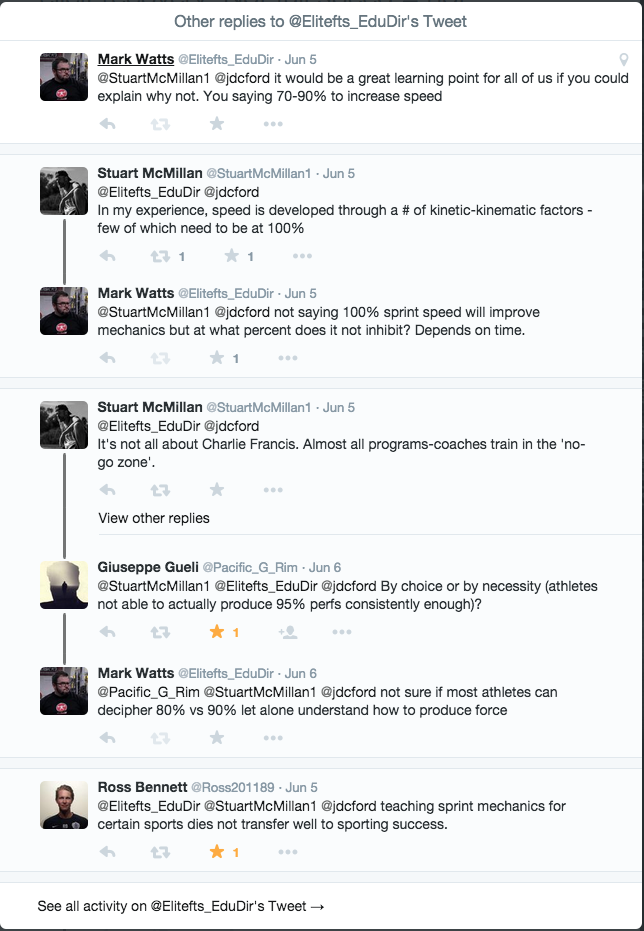
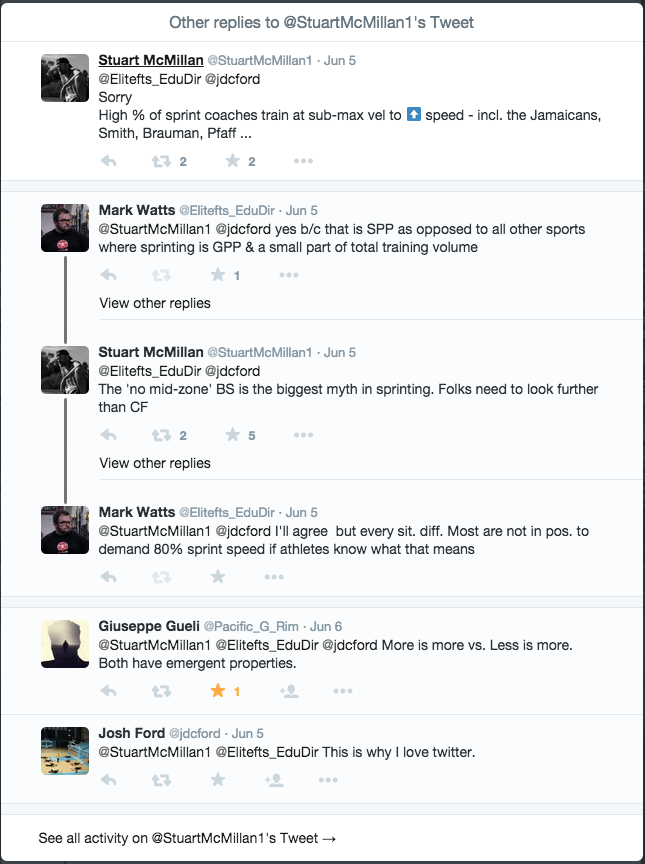
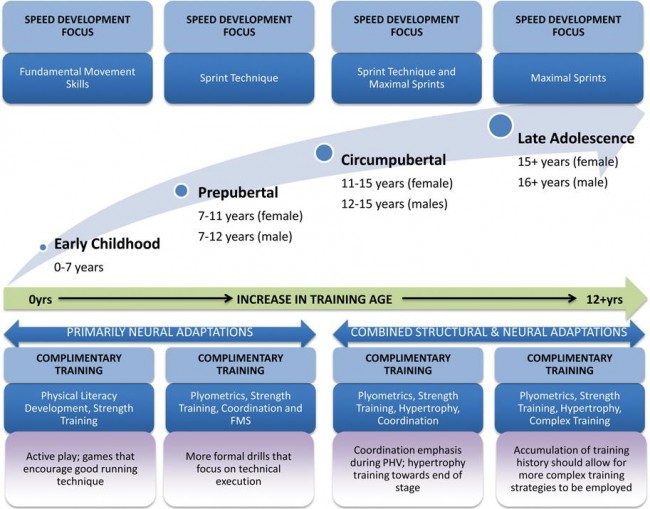

From my experience, speed is certainly related to strength and to technique.
But, it is also related to timing neurology. If an athlete's MFR signals are not precise, speed is reduced.
Think of speed as a harmonious symphony based on the MFR signals arriving at each of many 10s of thousands of individual muscle fibers at precisely the correct time for max speed from the body.
Now, what would happen to that symphony of signals are arriving plus or minus 30ms off the precise time for max speed.
After physical conditioning and before technique, it is best to get those timing signals precisely fine-tuned, so that the timing errors max out at plus or minus 5ms.
Timing is easy to test these days, send me an email and we can set up a test.
Rodger
1) Mechanics certainly do play a role - Mechanics are not a sexy or fun to work on and they are much harder to objectively see improvement in, but they are still vitally important and any coach who is not taking quality time to work on them is short changing the movement capabilities of their athletes. In fact a few papers have come out showing the orientation of force production is more important than the amount. The title of the original paper is: TECHNICAL ability of force application as a determinant of sprint performance (JB Morin, 2011). This demonstrates it's not as clear as more force = more speed and we need to stop saying that.
The study review you linked by Mr. Colquhoun even stated that relative strength between the two groups was the same, yet speed over 20m was different, giving reason to something else other than strength factoring into speed (mostly likely overall athleticism, elastic abilities, and mechanics). I don't see the conclusion of relative strength = acceleration when the two groups have the same relative strength and same time after 5m. And if absolute strength = top-end speed then the world's strongest squatters would also be the fastest, and we know these guys couldn't win a high school 100m race.
The thing I see is that we need to stop thinking that it only comes down to strength or mechanics - there are so many other factors and probably most important in the equation is good genetics. Strength will get untrained and young athletes faster for sure, but as they move up levels of mastery, this effect is far less just as the paper looking at Oklahoma States football S&C training showed - athletes from Freshman to Senior year got bigger and stronger, but not faster (Jacobsen et al, 2013). Strength works for younger, lesser trained athletes, but technical and mechanical influences definitely dictate success the older, more trained an athlete gets.
We know that maximal force takes ~.70sec to produce and we know acceleration = ~.20sec and top-end= ~.08. When looking at this information, my interpretation is that maximal strength has a limited role on speed and other factors are probably more important.
2) You asked, How much time do we really have to teach mechanics when they are learning other sport skills?
I feel the mechanics of acceleration and top-end sprinting have better transfer and carryover to the skills they are learning for their sport than say learning an Oly or squat won't they? Many sport skills have some sort of sport specific action and then it turns into a linear speed action, right? Make a cut - then linear speed. Rotate 180-degrees - then linear speed. Lateral crossover step - then linear speed. Again, this is my interpretation, and how I feel this skill development will enhance and benefit the sport mechanics they are learning from their sport coaches.
3) You posed these questions - The biggest questions I have for coaches who emphasise mechanics over physical qualities are:
1. How do you know your mechanics drills are having a carryover when the athlete is running full speed?
They get faster, how else do you judge what you do. It's the same question as how do you judge your strength training is carrying over to running full speed - your athletes get stronger. But as with either side, their are many factors and they are different for every athlete.
2. Will the athletes revert back to older habits in a competitive setting?
Possibly, but the hope is not as much. An athlete may look great with an 80% load on Hang Clean, but amp up to a 1RM and you'll often see all go to hell, so why do progressions and mechanic work for that? It's the same risk as anything, you hope it sticks, just as a QB coach hopes a QB maintains his mechanics when it's 4th down late in a game, but there is a chance he may revert back to poor mechanics, but that doesn't mean you don't try to improve them. As Coach Shaw stated, his athlete reverted back to his old mechanics, maybe it wasn't as bad as before and maybe other areas outside of his arm mechanics did improve, but only Coach Shaw could tell us that.
3. Are the drills you are implementing not addressing the physical qualities of improving speed other that motor skills i.e. strength, etc.?
Some aren't, some are. I can't speak for Coach McMillan, but when we're talking about skill acquisition, there will be some chunking to emphasize motor learning, and others will most definitely improve other physical qualities like strength, eccentric control, mobility, elasticity, etc.
Overall, I think we agree on a lot more than we disagree on - Like you said, I think the biggest problem is the lack of focus on actually training full acceleration/speed due to lack of rest periods AND lack of mechanical training. The quote you relayed from Coach Schexnayder is spot on, you can't get faster unless you're actually training speed, and giving short rest periods or running 300y shuttle isn't going to do this and this is a major disconnect and was the theme of your original quote. I agree with much of what you said, with the exception I think it is most definitely possible to incorporate adequate amounts of both strength and mechanics training within the given time constraints of a collegiate S&C.
Thanks for all your work Mark, you've made EliteFts a much better Sport Performance outlet since you've been there and I truly appreciate your dedication to the field.